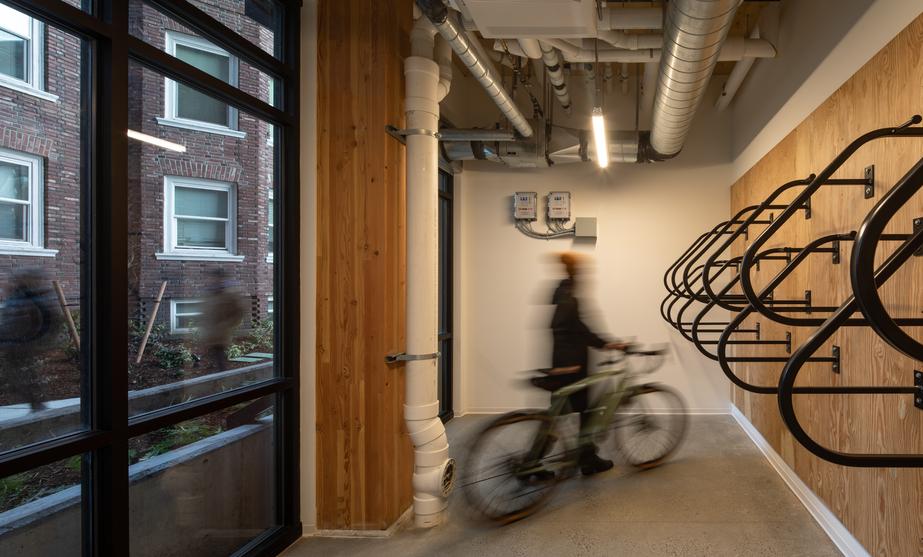MASS TIMBER:A SUSTAINABLE REVOLUTION SHAPING THE FUTURE OF CONSTRUCTION
By Andrew Pearl
For years, innovators have applied cutting-edge technologies to enhance wood’s key qualities. Products such as glued laminated timber (glulam) have been manufactured for over a century to make durable timber in complex shapes, while rigid and dimensionally stable products such as cross-laminated timber (CLT) are relatively new to the North American market. These products offer builders tremendous potential for innovative design, structural stability, cost efficiency, schedule efficiency and sustainable building.
ENVIRONMENTAL IMPACT
The 2023 International Mass Timber Report illustrates how mass timber can propel the North American construction industry toward its sustainability goal of carbon neutrality by 2034. With its low carbon footprint and ability to sequester carbon dioxide (CO2), mass timber has the potential to significantly reduce global CO2 emissions associated with construction activities.
Mass timber mitigates climate change in three ways:
1. Carbon sequestration: trees, through photosynthesis, capture CO2 from the atmosphere, reducing the overall CO2 in the atmosphere.
2. Carbon storage: wood and other bio- based materials retain CO2 in long-term applications instead of being released into the environment through decomposition or combustion. When amassed sufficiently, the cumulative carbon sequestered can potentially surpass that of an unmanaged forest.
3. Carbon substitution: mass timber, with 30% to 50% fewer CO2 emissions compared to traditional concrete and steel structures, provides a compelling alternative, steering clear of high-embodied carbon materials.
INNOVATION AND VERSATILITY
Mass timber lends itself to innovative applications where standard materials or techniques may prove too heavy or expensive. Its unique combination of strength and light weight make mass timber ideal for projects such as tall buildings, which require greater stability. The comparative weight advantage is staggering. A timber building, on average, weighs only 20% as much as its concrete or steel counterpart. This advantage is especially significant for sites with poor soil conditions, pressure limitations or high seismic activity, where a lighter building could be built larger and taller than a heavier building without compromising stability.
MASS TIMBER AND THE FUTURE OF CITIES
With its intrinsic sustainability, reliability and aesthetic appeal, mass timber promises to be the future of construction. To move urban environments into a greener future, contractors must engage with city and state regulatory agencies to advocate for updates to building codes that support the use of mass timber in commercial buildings.
Swinerton’s Heartwood project in Seattle exemplifies the power of this collaborative approach. Heartwood is Seattle’s first mass timber middle-income housing development, challenging traditional building practices via a new, replicable typology for mid-rise residential projects. The project utilizes CLT with exposed glulam columns and beams and is the first Type IV-C tall timber building entitled through the City of Seattle under the newly adopted 2021 International Building Codes (IBC), following the exact IBC provisions by design.
The West Coast is not the only place experiencing a mass timber breakthrough. A 2022 update to the New York City Building Codes explicitly provides for mass timber elements, aiding Local Law 97’s goal to establish carbon neutrality in the city by 2050 — one of the country’s most ambitious plans for reducing emissions. Additionally, the New York City Economic Development Corporation launched the New York City Mass Timber Studio this year to support the development of mass timber projects in their early phases.
Since Swinerton expanded its operations into New York City in 2021, the firm has been at the forefront of the new opportunities. Also breaking into the East Coast scene is Timberlab, a wholly owned entity of Swinerton Incorporated offering design-build mass timber services.
The mass timber firm recently opened its East Coast glulam fabrication facility — located in Greenville, South Carolina — to build on the momentum of mass timber adoption across the eastern United States and to tap into the abundance of durable and fast-growing southern yellow pine, which has emerged as the preferred species for many architects.
THE FUTURE UNVEILED
The push for sustainable buildings and cities is dramatically shaking up the construction landscape, and regulatory updates are finally beginning to recognize the cost savings, improved sustainability and streamlined construction benefits that position mass timber as an integral piece of the movement.
The future of wood-based construction lies in reimagining and reclaiming one of the world’s oldest building materials to provide sustainable economic growth and preserve the environment. But to do this, firms need to remain nimble, adaptable and open to whatever comes next in the dynamic world of mass timber construction.



